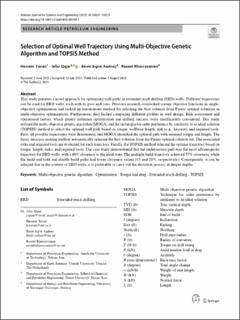| dc.contributor.author | Yavari, Hossein | |
| dc.contributor.author | Qajar, Jafar | |
| dc.contributor.author | Aadnøy, Bernt Sigve | |
| dc.contributor.author | Khosravanian, Rasool | |
| dc.date.accessioned | 2024-03-14T09:55:20Z | |
| dc.date.available | 2024-03-14T09:55:20Z | |
| dc.date.created | 2023-09-27T12:30:45Z | |
| dc.date.issued | 2023 | |
| dc.identifier.citation | Yavari, H., Qajar, J., Aadnoy, B. S., & Khosravanian, R. (2023). Selection of optimal well trajectory using multi-objective genetic algorithm and TOPSIS method. Arabian Journal for Science and Engineering, 48(12), 16831-16855. | en_US |
| dc.identifier.issn | 2193-567X | |
| dc.identifier.uri | https://hdl.handle.net/11250/3122351 | |
| dc.description.abstract | This study presents a novel approach for optimizing well paths in extended reach drilling (ERD) wells. Different trajectories can be used for ERD wells, each with its pros and cons. Previous research overlooked certain objective functions in single-objective optimization and lacked an autonomous method for selecting the best solution from Pareto optimal solutions in multi-objective optimizations. Furthermore, they lacked comparing different profiles in well design. Risk assessment and operational factors, which greatly influence optimization and drilling success, were insufficiently considered. This study utilized the multi-objective genetic algorithm (MOGA) and the technique for order preference by similarity to an ideal solution (TOPSIS) method to select the optimal well path based on torque, wellbore length, risk (e.g., keyseat), and required tools. First, all possible trajectories were determined, and MOGA identified the optimal path with minimal torque and length. The fuzzy decision-making method automatically selected the best solution from the Pareto optimal solution set. The associated risks and required tools are evaluated for each trajectory. Finally, the TOPSIS method selected the optimal trajectory based on torque, length, risks, and required tools. The case study demonstrated that the undersection path was the most advantageous trajectory for ERD wells, with a 60% closeness to the ideal state. The multiple build trajectory achieved 57% closeness, while the build and hold and double build paths had lower closeness values (43 and 28%, respectively). Consequently, it can be inferred that in the context of ERD wells, it is preferable to carry out the deviation process at deeper depths. | en_US |
| dc.language.iso | eng | en_US |
| dc.publisher | Springer | en_US |
| dc.rights | Navngivelse 4.0 Internasjonal | * |
| dc.rights.uri | http://creativecommons.org/licenses/by/4.0/deed.no | * |
| dc.title | Selection of Optimal Well Trajectory Using Multi-Objective Genetic Algorithm and TOPSIS Method | en_US |
| dc.type | Peer reviewed | en_US |
| dc.type | Journal article | en_US |
| dc.description.version | publishedVersion | en_US |
| dc.rights.holder | The authors | en_US |
| dc.subject.nsi | VDP::Teknologi: 500::Berg‑ og petroleumsfag: 510 | en_US |
| dc.source.journal | Arabian Journal for Science and Engineering | en_US |
| dc.identifier.doi | 10.1007/s13369-023-08149-1 | |
| dc.identifier.cristin | 2179367 | |
| cristin.ispublished | true | |
| cristin.fulltext | original | |
| cristin.qualitycode | 1 | |

